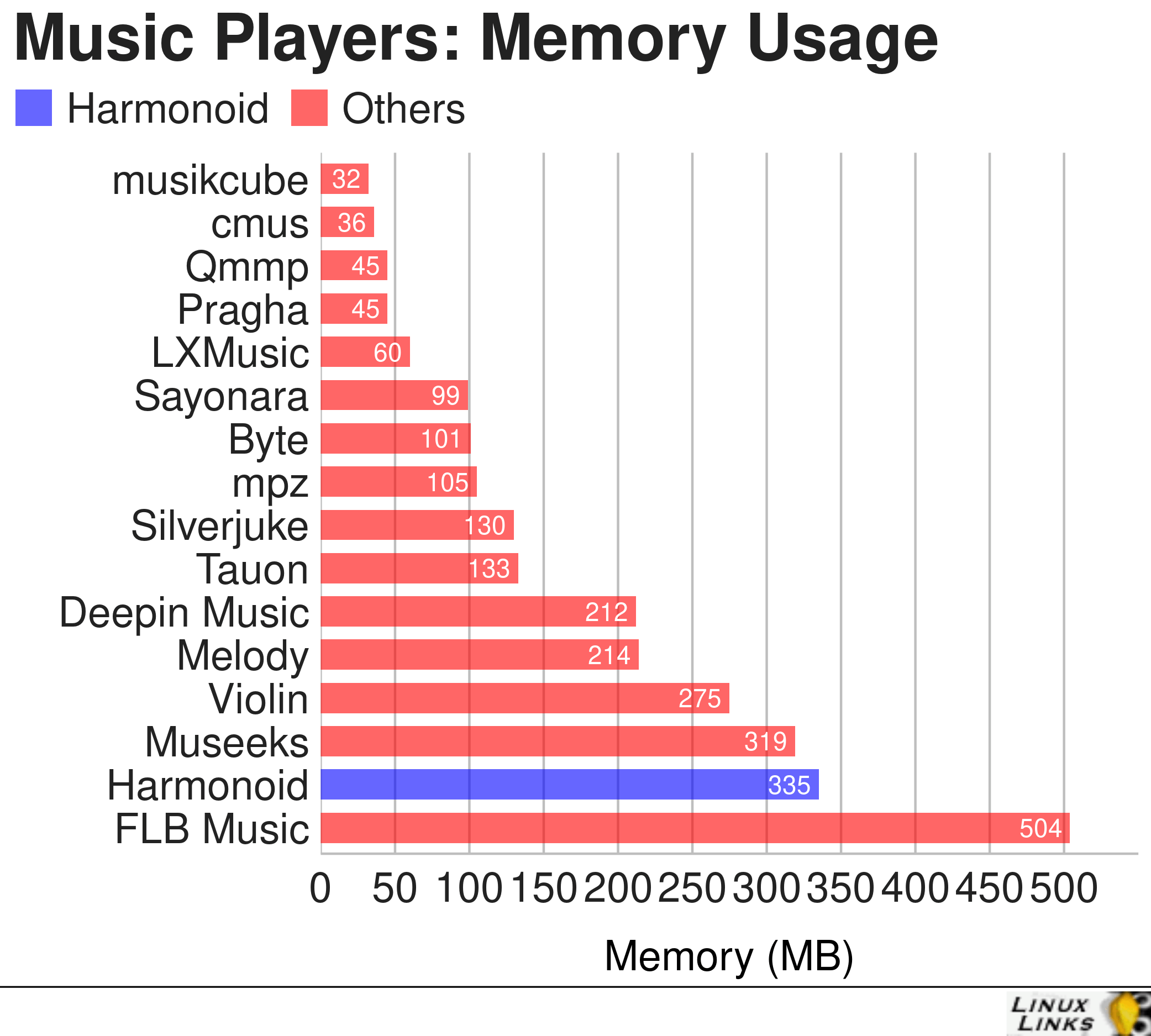Last Updated on March 13, 2022
Memory Usage
Here’s a chart that shows Harmonoid’s memory usage compared to a range of other popular open source music players.
The developer claims the software uses less than 120MB of RAM in operation. We couldn’t validate that figure. Even with our default music collection (which is a small number of albums released under an open source license), music usage was considerably higher. ps_mem reports that the program uses around 335MB of RAM.

Let’s put the 335MB of RAM into context. As the chart above shows, Harmonoid is certainly not frugal in comparison with almost all music players. Only Electron-based music apps such as FLB Music consume more memory. That’s a disappointing result, but if your system has plenty of RAM this shouldn’t be a major drawback.
Pages in this article:
Page 1 – Introduction / Installation
Page 2 – In Operation
Page 3 – Memory Usage
Page 4 – Summary

YouTube playback didn’t work for me either.
I’ve been using Clementine for years. It has a superb feature set, perfect for listening to internet radio, and works under Linux, macOS and Windows and even control the software from my cell phone.
I agree, Clementine is the beat music player yet.
Based on the article alone, feels like a language learning project creator wants to try and milk. No harm in that, the creator will learn some valuable lessons about reality
learn about reality? I doubt it. More likely they will learn some programming
Hey! I see you recently published this article… And I see it’s using the non-updated version… Flatpak release is not yet updated… The whole UI is revamped compared to what you have actually shown.
Atleast you could match the UI… Very bad review & research.
Plus, project is not even 1.0.0 stable yet.
The old version that you reviewed already has all its libraries open source.
Install again & review again. Flatpak version isn’t updated & I didn’t expect people can’t even match version numbers.
It appears you published a new release shortly after Luke wrote his review.
It could be, I don’t know how. I don’t maintain flatpak packaging since I mainly target Windows. Author has cited that app does not store folders in cache & that’s not true, its something that one of our contributors just made a flatpak packages which run sandboxed & “cache” needs to be stored in the same directory.
Apart from this, the app is made possible with Flutter engine, which doesn’t even have official Linux support yet. And that in itself is a big challenge, writing everything from ground-up, C libraries to Dart UI.
I looked at the latest release and it’s utter shite. Prime to crashing,memory hog and poorly implemented
Unfortunately we are so far from 1.0.0, current version is just 0.2.0… and project is at infancy. there have been barely 3 versions out yet (that even randomly “releasing” on my GitHub README)…
It’s a common mistake by developers that giving version numbers confers any real information about the maturity of a project given there is often inconsistency about version numbers between different projects.
I have seen many open source projects that have releases below version 1.0 that are very stable with all main features implemented and settled APIs, and even things like MAME which has in development for 25 years where the developers have said they can never actually release a version 1.0.
Yet other software with version releases in double digits that have roadmaps indicating there are many key features yet to be implemented.
Open source projects that plan to include proprietary plugins/addons generally see their project receive significantly less support from the open source community particularly where there is mature open source projects doing the same thing already available.
There are many projects that tried this approach where it spectacularly backfired. For example, there was a file manager called Polo File Manager. I used it as my main file manager. The developer tried to offer plugins for money saying that they were available if you made a specific monetary donation. The open source community, of course, saw right through that approach. It wasn’t a donation at all.
What happened to Polo? As an open source project it died a horrible death. Abandoned by the original developer and shunned by the open source community.
Polo got to version 18 something and the developer was still labelling it as beta
Heh Luke
Thanks for the honest review. Your coverage of the multimedia software has saved me a lot of time
I note that the project has changed license terms in the past few days. It is no longer published under the GPL. Instead its EULA now says
(g) Source code.
You may only compile and modify the source code of the SOFTWARE PRODUCT for your own personal purpose or to propose a contribution to the SOFTWARE PRODUCT after removing refrences (sic) to all proprietary modules used within Harmonoid.
The software does not meet the criteria of an open source project. Avoid!
Indeed, Harmonoid is just grubby freeware.
It’s the classic bait-and-switch technique. Start a project, release it under an open source license, try to build a user base, and then remove the open source license for new releases. Disgusting behavior